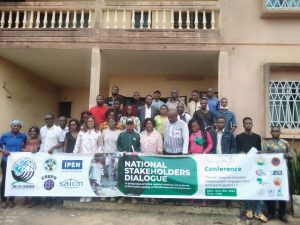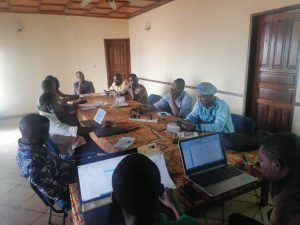The fight against toxic chemicals in products is yet to gain steam in the country.
“Most civil society organizations are not even aware of the existence of toxic chemicals in products”, says Blondel Silenou, Executive Director of JVE Cameroun during the workshop organized at the head office of the organization in Yaounde.

The situation is more preoccupying in the country because even the population is still ignorant of the dangers of such chemicals.
The National Stakeholder Dialogue workshop was in prelude to the Africa Regional Meeting and Pathway to the 4th SAICM intercessional process.
SAICM is the Strategic Approach to International Chemicals Management, adopted in 2006, and is a policy framework to promote chemical safety worldwide.
“We want to increase stakeholders engagement and participation”, Blondel Silenou told the press.
“At the end of this workshop we intend to identify a common position for Cameroon relative to the SAICM negotiations”, he continued.
Some African CSOs involved in the fight against toxic chemicals would meet in Accra Ghana from the 27-29 to discuss the SAICM process and adopt a common position to be taken to the global meeting in Germany.
Speaking at the workshop, Achille NGAKENG, IPEN Francophone Africa Regional Coordinator said the new SAICM should focus more on Africa.
“Africa produces less but suffers the effects more that every other continent”, he said.
IPEN, International Pollutants Network is an organisation that fights for a toxic free future to humans and nature.
The Toxic Fight
The fight against toxic chemicals gets its place due to the fact that chemicals have devastating effects on children.
Toys and many other children’s products can keep children happy for hours and the right ones are wonderful for encouraging development, creativity and can stir young imagination. However, children’s plastic toys can be a source of toxic chemicals, especially when the manufacturer is not properly regulated and laws are not sufficiently enforced.
“From a study we conducted in Cameroon on some randomly selected 22 pairs of PVC plastic articles including baby bottles, children’s toys and overalls, 3 out of the 22 items sampled abroad were contaminated with toxic heavy metals, i.e. less than 14 % while the rest were uninfected and safe for children. The two toxic heavy metals identified were Chromium and Cadmium.” Says Achille NGAKENG.
From birth, babies and kids are given teethers and plastic toys and a Non Governmental Organisations “JVE Cameroon and Terre et Développement” say not every plastic toy is created equal, It can be a surprising wake-up call for many parents to learn that some of their children’s favourite toys could be exposing them to harmful chemicals.

The element’s harmful consequences on children health include mental retardation, neurocognitive disorders, behavioral disorders, respiratory problems, cancer and cardiovascular diseases.
Research have shown that all children, both in the developing world like Cameroon and developed world are affected by exposure to hazardous chemicals. They are more at risk because they live life closer to the ground, crawling, digging in dirt and most often putting objects (plastic toys) in their mouth. These are natural behaviours and children should not be harmed by their toys.
“Despite the best intentions of parents, relatives, and friends, seemingly safe toys given to children this holiday season could contain another difficult-to-recognize surprise, so it is imperative for the public to and most especially parents to know the effects of toxic heavy metal ls on their children” Blondel SILENOU, President of Young Volunteers for the Environment “JVE Cameroon” told News Upfront.








